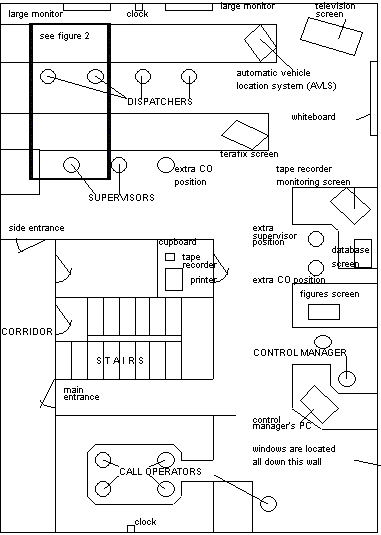
Small group of workers (1 control manager, 2 supervisors, 4 dispatchers, 2-8 call takers), location within a site (an ambulance control room) some collocation at specific desks. Some ability to oversee and overhear one another, and a shared ambulance logging, dispatch and resource management system with several public displays of various information. Focus on how the career trajectory of staff within the setting, serves to facilitate work achievement through building in the provision of supervision, advice, explanations and so forth by those in more senior positions. Furthermore, this allows those in these positions to carry out the activities concerned with the roles below then (that they have previous experience in carrying out).
The activities carried out by the various workers are facilitated by various representations and are recorded on various screens. For example, call takers record details of 999 calls onto computer based forms which are passed to the dispatchers (and supervisors) who in turn use various representations to select ambulances for dispatch and manage resources (see MultipleRepresentationsOfInformation and public artefact (PublicDisplayedArtefact)). The arrangement of the room and the use of a shared system explicitly promotes cooperation and supervision (especially by the control manager and supervisors). Therefore, the more senior workers have ready access to the work of the less senior, explicitly allowing them to monitor, supervise and check the work of others, To readily assist as the situation requires and to actively take over other roles through the system while sitting at their desks.


The left hand diagram shows the layout of the control room demonstrating that the supervisors have very direct access to overhearing and seeing the dispatchers from their desks and the control manager has moderate access to the whole room. The figure on the right shows the career trajectory of the workers, from call taker to control manager.
Coordination is facilitated through the arrangement of the control room and the shared computer aided dispatch system and its instantiation on both individual and shared screens. These constitute the local resources through which workers can continually apply an egological and alteriological orientation to work achievement. These resources are used in an individual and combinatory manner. These allow the more senior workers (particularly supervisors and control manager) to have access to other's work through the system, through observing others interaction with various artefacts and through overseeing/hearing. This in turn provides for supervision, checking, assistance and so forth and the ability to complete other workers task as the situation dictates. The on-going provision of assistance is mostly achieved through interactions of various sorts.
Intra organisational group of ambulance control room workers, focusing on the career trajectory through a series of roles and how this facilitates work achievement.